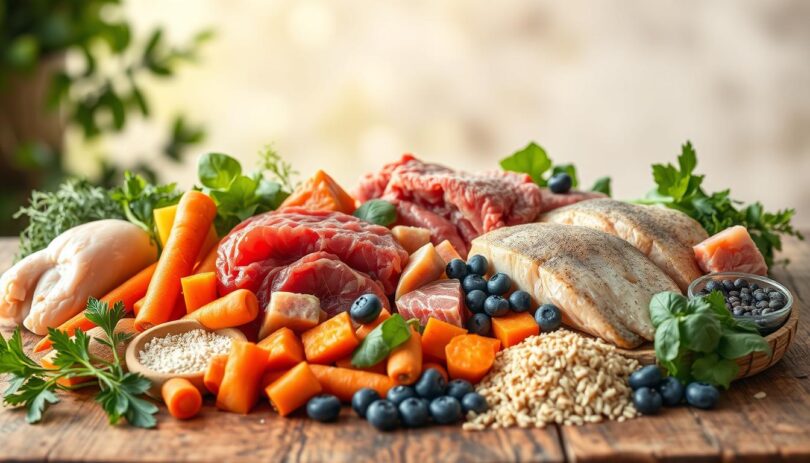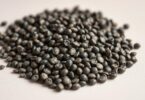Did you know 95% of commercial pet foods contain fillers that offer little nutritional value? Research shows fresh, whole-food meals can boost canine vitality by up to 40% while supporting digestion and energy levels. Switching to a natural approach doesn’t require chef-level skills—just a focus on quality ingredients and smart proportions.
Contrary to popular belief, crafting balanced meals for pets is simpler than most owners think. Studies in the Journal of Animal Science reveal that fresh proteins like chicken or beef, paired with low-lectin veggies such as sweet potatoes and broccoli, align perfectly with a canine’s biological needs. These human-grade ingredients aren’t just digestible—they’re packed with nutrients that promote healthier coats and stronger immune systems.
Many worry about getting ratios right, but trusted resources like the best diet recipes simplify the process. Whether using USDA-compliant flash-frozen mixes or homemade combinations, the key lies in consistency and variety. Even busy households can maintain this routine with proper planning.
This guide breaks down everything from portion sizes to cost-effective strategies, backed by veterinary insights. You’ll discover how everyday ingredients become powerful tools for longevity—no advanced degree required.
Understanding Your Dog's Nutritional Needs
Building a healthy diet starts with knowing what fuels your companion’s body. Like humans, pets require precise combinations of proteins, fats, and carbohydrates—plus key vitamins and minerals—to thrive. Let’s explore how these elements work together.
The Powerhouse Trio: Proteins, Fats & Carbs
Proteins act as building blocks for muscles and tissues. High-quality sources like chicken or fish provide amino acids that support growth and repair. Fats from oils like fish or flaxseed deliver concentrated energy while promoting shiny coats and brain health.
| Nutrient | Primary Role | Best Sources |
|---|---|---|
| Protein | Muscle maintenance | Chicken, salmon, eggs |
| Fat | Energy & skin health | Fish oil, coconut oil |
| Carbs | Digestive support | Sweet potatoes, oats |
Vitamins & Minerals: The Silent Supporters
Essential nutrients like calcium and vitamin E strengthen bones and boost immunity. Leafy greens and carrots supply antioxidants, while zinc from meats aids metabolism. Balance is key—too little vitamin D weakens bones, but excess iron can be harmful.
Fresh ingredients maximize nutrient absorption. For example, lightly steamed broccoli retains more vitamins than overcooked veggies. Always consult trusted resources to avoid harmful foods like onions or chocolate.
Creating a Balanced Dog meal plan
Designing a nutritionally complete routine for your pet requires understanding their unique needs. Start by focusing on ratios: 2/3 of each portion should come from quality meats, while the remaining third combines vegetables and nutrient boosters like eggs or fish oil.
Guidelines for Designing Nutritious Meals
Prioritize lean proteins like turkey or beef as the foundation. Pair them with fiber-rich veggies such as spinach or pumpkin. Rotate ingredients weekly to provide diverse vitamins and minerals. For example:
| Weight Range | Daily Portion | Meat Ratio |
|---|---|---|
| 10-20 lbs | 1-1.5 cups | 65% |
| 21-50 lbs | 2-3.5 cups | 70% |
| 51+ lbs | 4-6 cups | 60% |
Determining Caloric and Portion Needs
Active pets typically need 30 calories per pound daily, while seniors may require 20% less. Use this formula: (Weight in lbs x 30) – (adjustment for age/activity). Measure portions with a kitchen scale for accuracy—even small errors can impact energy levels.
Adjust amounts gradually if your companion gains or loses weight. Most recipes suggest splitting food into two daily meals to maintain steady metabolism. Always consult your vet before making significant diet changes.
Selecting Quality Ingredients and Portion Sizes
Great nutrition begins at the grocery store. Choosing premium ingredients and measuring them correctly ensures your companion gets maximum benefits from every bite.
Fresh Proteins Build Strong Bodies
Opt for human-grade meats like chicken thighs or lean ground beef. Organ meats like liver offer concentrated nutrients—aim to include them weekly. Always verify sources: look for USDA-inspected labels or local farm partnerships.
Veggies and Carbs Add Vital Nutrients
Cooked sweet potatoes provide digestible fiber, while steamed carrots deliver beta-carotene. Rotate seasonal vegetables to prevent boredom. Avoid raw starches—lightly roast or boil them for better absorption.
| Weight (lbs) | Daily Meat | Veggies/Carbs |
|---|---|---|
| 10-20 | 6 oz chicken | 3 oz potatoes |
| 21-50 | 12 oz beef | 5 oz mix |
| 51+ | 18 oz mix | 8 oz blend |
Measure Smart for Optimal Health
Use a kitchen scale for accuracy—cooked portions shrink by 25%. Raw meaty bones like turkey necks clean teeth naturally. Always supervise chewing sessions.
Store meats frozen until use, and wash produce thoroughly. Small upgrades—like switching to organic liver or purple carrots—can enhance nutrient density without complicating prep.
Preparing and Storing Homemade Dog Food
Transforming your kitchen into a safe meal-prep hub ensures your companion enjoys nutritious meals without risks. Start by designating clean workspace zones and gathering BPA-free containers—organization prevents cross-contamination and streamlines the process.
Effective Cooking and Safety Techniques
Gentle cooking preserves nutrients. Blanch veggies like carrots for 3 minutes to retain vitamins, then chop them finely. Cook proteins like turkey or beef at medium heat until internal temps reach 165°F—critical for eliminating bacteria. Always use separate cutting boards for meats and produce.
Batch cooking saves time. Mix 5 lbs of cooked meat with steamed sweet potatoes and peas in a food processor. Portion meals using a kitchen scale—accuracy matters for weight management. Store servings in labeled containers with dates.
| Storage Method | Temperature | Max Duration |
|---|---|---|
| Refrigeration | 32–39°F | 5 days |
| Freezing | 0°F or below | 3 months |
Proper Freezing and Thawing Methods
Freeze foods in single-meal portions using silicone molds. Thaw overnight in the fridge—never microwave, as uneven heating destroys nutrients. Discard unused thawed foods after 48 hours.
Sanitize surfaces with vinegar solutions weekly. Wash bowls after each use to prevent biofilm buildup. For safe handling of proteins, freeze raw meats immediately after purchase unless cooking same-day.
Track your companion’s weight biweekly using a vet-approved scale. Adjust portions if needed—every 0.5 lb change warrants a 10% food adjustment. Consistent routines turn home-cooked feeding into an efficient, health-boosting habit.
Transitioning from Commercial to Homemade Meals
Switching your companion’s diet requires patience and strategy. Sudden changes can upset their digestive system, leading to discomfort or food rejection. A gradual approach helps their body adapt while allowing you to observe reactions.
Gradual Diet Changes and Schedule Tips
Start by mixing 20% homemade food with 80% commercial kibble on day one. Increase the ratio every 48 hours until reaching 100% new meals by day six. This slow shift gives gut bacteria time to adjust, reducing gas or loose stools.
| Transition Day | Homemade Food | Commercial Food |
|---|---|---|
| 1-2 | 20% | 80% |
| 3-4 | 50% | 50% |
| 5-6 | 80% | 20% |
| 7+ | 100% | 0% |
Serve meals at consistent times to maintain routine. Warm homemade portions slightly to enhance aroma—this encourages picky eaters. If your companion hesitates, try adding low-sodium broth for extra appeal.
Monitoring Your Companion’s Weight and Health
Track weight weekly using a reliable scale. Sudden loss could mean insufficient calories, while gain suggests overfeeding. Check stools daily—ideal consistency is firm but not dry.
Watch for itching, lethargy, or vomiting. These may signal food sensitivities. Always keep your vet informed during transitions. They can recommend blood tests or supplements to address gaps in nutrition.
Most pets show improved energy and coat shine within 14 days. For seniors or pets with health issues, extend the transition to 10 days. Small adjustments create lasting benefits without overwhelming their system.
Tips for Customizing Meals to Your Dog's Individual Needs
Every canine companion has unique nutritional requirements shaped by their lifestyle and biology. Tailoring recipes ensures they receive precise fuel for their energy levels, health status, and life stage. Start by observing patterns in digestion, coat quality, and activity to identify what works best.
Adjustments for Age, Activity, and Health Conditions
Active pets thrive with higher protein ratios—think 75% lean meats or fish. Salmon and sardines deliver omega-3 fatty acids that reduce skin irritation and promote glossy coats. For seniors, softer textures and joint-supporting nutrients like glucosamine become essential.
Fruits like blueberries or apples (seedless) add antioxidants without excess sugar. If allergies occur, swap common proteins like chicken for novel sources such as venison or rabbit. Always introduce one new ingredient weekly to pinpoint reactions.
| Condition | Recommended Additions | Avoid |
|---|---|---|
| Sensitive Skin | Flaxseed oil, mackerel | Wheat, soy |
| Low Energy | Beef liver, pumpkin | High-fiber fillers |
| Weight Management | Green beans, turkey breast | Starchy potatoes |
Track changes in stool quality, itching, or energy spikes. Consult your vet before adding supplements like fish oil capsules. Small breeds often need calorie-dense meals, while larger animals benefit from controlled portions to prevent joint strain.
Remember: successful customization balances science with observation. Keep a food journal noting ingredient responses, and celebrate when your furry friend licks their bowl clean—it means you’ve nailed their perfect formula.
Final Thoughts on a Nutritious Canine Dining Experience
Embracing a homemade approach transforms everyday feeding into an act of love and science. By prioritizing fresh proteins, vibrant veggies, and balanced ratios, you create meals that fuel vitality while deepening your bond. Regular monitoring—like weekly weight checks and stool assessments—helps fine-tune portions to match your companion’s evolving needs.
Consistency matters most. Rotate ingredients seasonally to maintain interest and nutrient diversity. Partner with your vet to address gaps, ensuring recipes meet calcium, vitamin B12, and other critical requirements. Small adjustments based on energy levels or coat changes make a big difference over time.
This journey isn’t about perfection but progress. Each thoughtfully prepared bowl supports digestion, immunity, and longevity. Celebrate milestones like shinier fur or playful energy—they’re proof your efforts work.
Ready to start? Begin with simple recipes, track responses, and adjust as needed. Your furry friend’s thriving health is the ultimate reward—one delicious, nourishing bite at a time.
FAQ
What’s the ideal protein-to-vegetable ratio for homemade recipes?
A balanced canine diet typically contains 50% lean meats like chicken or beef, 25% digestible carbs such as sweet potatoes, and 25% chopped vegetables like carrots or green beans. Always adjust ratios based on your pet’s activity level and consult a vet for breed-specific needs.
Can I use raw liver in my pet’s food preparation?
Cooked liver is safer than raw to avoid bacterial risks. Serve it sparingly—about 5% of weekly meals—as it’s rich in vitamin A. Overconsumption may lead to toxicity. Pair with omega-3 sources like salmon oil for skin health.
How long can refrigerated portions stay fresh?
Store cooked meals in airtight containers for up to 4 days. For longer preservation, freeze in portioned bags for 2-3 months. Thaw overnight in the fridge; never microwave to prevent nutrient loss. Brands like Petmate offer BPA-free storage solutions.
Are blueberries safe for daily consumption?
Yes, blueberries provide antioxidants but should comprise ≤10% of daily intake. Mash them for small breeds to prevent choking. Avoid grapes, raisins, and citrus fruits, which are toxic. Introduce new ingredients gradually to monitor digestion.










Leave a Comment